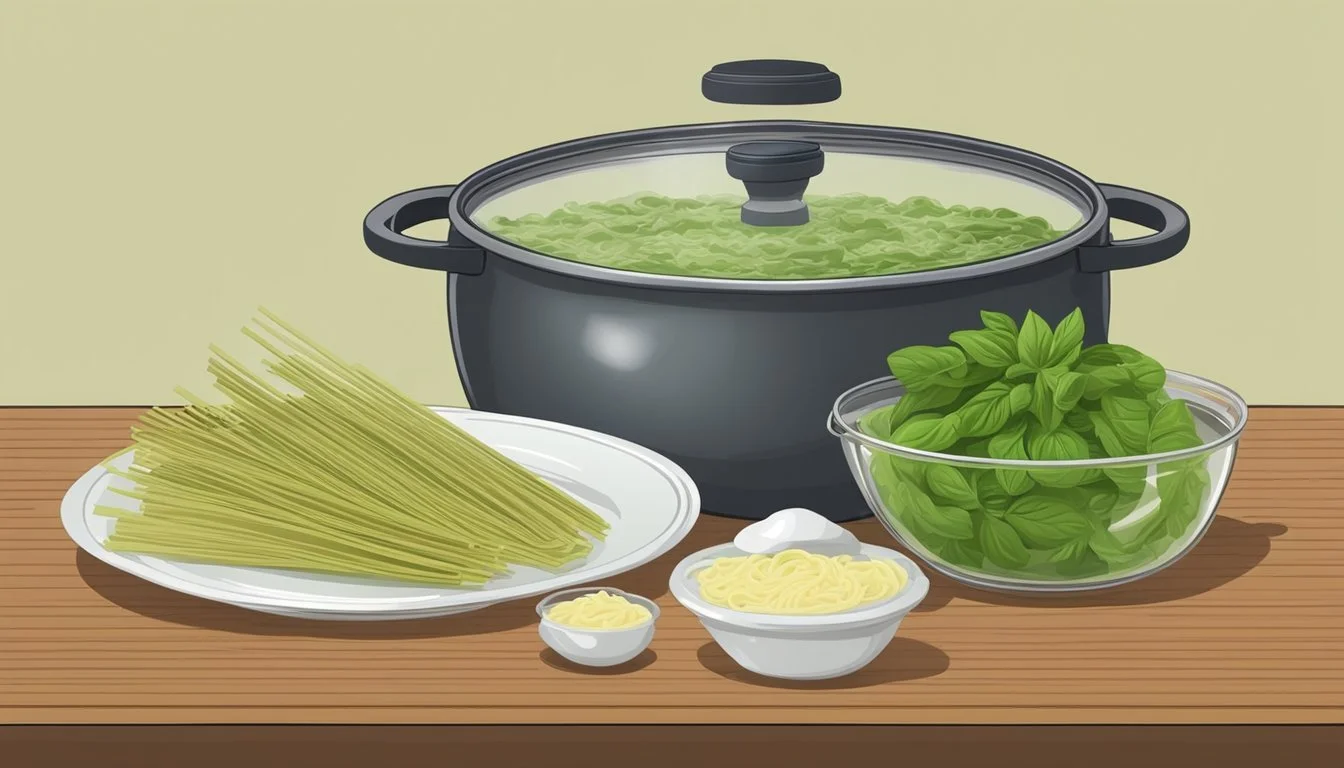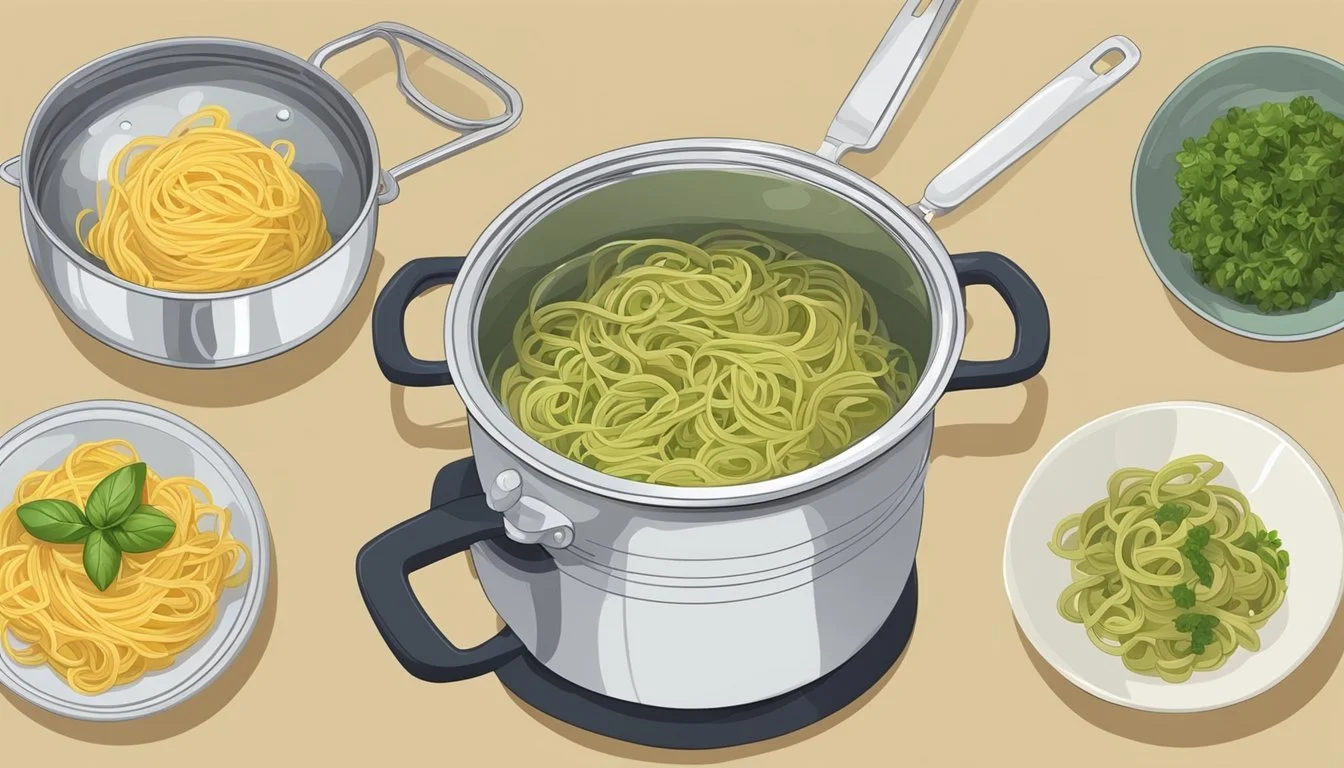How to Reheat Fettuccine with Pesto
Expert Tips for Perfect Flavor and Texture
Reheating fettuccine with pesto can be a delicate process, but it’s essential for maintaining the dish's vibrant flavors and creamy texture. When done correctly, the key to reheating leftover pesto pasta is to gently reheat it without drying it out or causing the sauce to separate.
For a quick method, placing the pasta in an oven-safe dish with some leftover pesto or olive oil and covering it with foil helps retain moisture. Alternatively, using a double boiler or microwave with careful monitoring can both yield excellent results without sacrificing taste.
Ensuring the reheating process is done safely and properly can make your leftover fettuccine as delightful as when it was first cooked. Proper techniques will not only preserve the taste but also the texture of the pasta, making it a convenient and delicious meal option.
Understanding Pesto Pasta
Pesto pasta combines aromatic basil, garlic, pine nuts, and Parmesan cheese to create a flavorful dish. Properly storing leftovers and choosing the right pasta type ensure that your meal retains its deliciousness when reheated.
The Basics of Pesto
Pesto, a green sauce with a fresh and vibrant flavor profile, originates from Italy. The traditional recipe typically includes basil leaves, garlic, pine nuts, Parmesan cheese, and olive oil. These ingredients are blended to form a sauce that can be enjoyed with various pasta recipes.
Quality matters—fresh pesto made from garden-picked basil will always outperform its store-bought counterparts in both taste and texture.
Pasta Considerations
When making pesto pasta, the choice of pasta is crucial. Fettuccine, known for its flat and broad noodles, pairs well with the creamy texture of pesto. Cooking the pasta al dente ensures it retains its firmness when mixed with the sauce.
Overcooked pasta can become mushy, which negatively affects the dish. Using boiling water and properly salting it enhances the overall taste.
Storing Leftover Pesto Pasta
Storing leftover pesto pasta properly is key to preserving its flavor and texture. Once cooled, place the pasta in an airtight container. Refrigeration is suitable for short-term storage, while freezing can extend its shelf life.
Tips for Storage:
Refrigerate leftovers within two hours.
For best results, consume refrigerated pasta within three days.
Use freezer-safe containers for freezing, keeping pasta for up to three months.
When stored correctly, reheated pasta can still offer a delightful meal with rich flavors.
Preparation for Reheating
Before reheating fettuccine with pesto, it's essential to properly portion the pasta and ensure it retains moisture to avoid dryness.
Portioning and Setting Up
Start by dividing the leftover pasta into manageable portions. This step helps in evenly reheating the pasta and prevents some parts from overcooking while others remain cold.
Use a microwave-safe dish or an oven-safe dish and spread the pasta evenly across the container. If you have optional ingredients like tomatoes, consider chopping and adding them at this stage to ensure they heat alongside the pasta.
If using a microwave, cover the dish with plastic wrap or a damp paper towel to trap steam. For oven reheating, cover the dish with aluminum foil.
Adding Moisture
To maintain a creamy texture, it's crucial to add moisture to the cold pesto pasta. One practical method is to blend a bit of olive oil or butter with the pasta. This step not only prevents the pasta from drying out but also enhances the flavor.
If you have leftover pasta water, mix a small amount into the dish. The starchy water helps to revive the sauce to its original consistency.
In an oven, you can also sprinkle some water before covering with aluminum foil, aiding in moisture retention. These adjustments ensure that the reheated fettuccine remains delicious and appetizing.
Choosing the Reheating Method
The method you choose to reheat fettuccine with pesto impacts its flavor and texture. Below, find three common methods: microwave, oven, and stovetop.
Microwave Reheating
Microwaving is quick and convenient. Start by placing the fettuccine in a microwave-safe dish. Sprinkle a small amount of water (about a tablespoon) to help retain moisture. Cover the dish with plastic wrap or a microwave-safe lid, leaving a small vent to release steam.
Microwave on medium power to ensure even heat distribution. Heat in 30-second intervals, stirring after each to check for uniform temperature. Avoid overcooking to prevent the pasta from becoming gummy. This method is ideal for busy days but may not preserve the bright colors of your dish as well.
Oven Reheating
Using an oven is beneficial for reheating larger quantities, offering gentle and even heating. Preheat the oven to 350°F (175°C). Place the pasta in an oven-safe dish and cover it with aluminum foil to retain moisture.
Heat the pasta for about 15-20 minutes. Stir once halfway through to distribute the heat evenly. Residual heat will continue to warm the pasta after it’s removed from the oven. This method maintains the integrity and flavor of the pesto but takes longer compared to the microwave.
Stovetop Reheating
The stovetop method is favored for its ability to revive the pasta's texture and flavors. Heat a small amount of olive oil or butter in a skillet over medium heat. Add the fettuccine once the oil or butter is hot.
Use tongs to toss the pasta gently, ensuring it heats evenly. If the pasta seems dry, add a splash of water or leftover broth. Stir often to avoid sticking and burning. This method offers excellent control over heat and texture, making it ideal for maintaining the dish's original delightful freshness.
Additional Tips and Variations
Achieving the perfect reheat for fettuccine with pesto involves attention to detail and creativity. Key focuses include avoiding overcooking, enhancing flavors, and considering complementary pairings and additions.
Avoiding Overcooking
To prevent overcooking, heat the pasta gently and monitor the texture. Microwave Methods: Use a microwave-safe dish, cover it with a paper towel, and microwave on high power for 4-7 minutes, checking frequently to ensure the pasta remains al dente. Oven Methods: Cover with foil to lock in moisture, and heat at 350 degrees Fahrenheit for 20 minutes, ensuring it stays moist and textured. Stovetop Methods: Use a non-stick pan over medium heat with a small amount of olive oil, stirring gently to avoid mushiness.
Enhancing Flavor
Enhancing the flavor of reheated fettuccine with pesto can be simple and rewarding. Add a splash of fresh pesto, or olive oil to revive the dish's vibrancy. For a rich, savory touch, sprinkle Parmesan cheese and freshly ground salt and pepper over the pasta. Fresh ingredients like basil leaves can elevate both flavor and presentation. Consider adding thinly sliced tomatoes or a handful of spinach for an extra layer of taste. A squeeze of lemon juice can also brighten the flavors without adding calories.
Pairings and Additions
Pairing your fettuccine with pesto with the right sides can complement and enhance the meal. Grilled chicken or shrimp are excellent for adding protein and depth. For a vegetarian option, roasted vegetables like bell peppers, zucchini, or cherry tomatoes can add a burst of color and nutrients. Using red pesto instead of green can provide a hearty variation. Adding a side salad with fresh greens, spinach, and a light vinaigrette can balance the dish. For those craving a richer sauce, a marinara on the side can add a robust flavor without overshadowing the delicate pesto.
Final Touches
After reheating the fettuccine with pesto, adding fresh basil can enhance the flavor. Tear a few leaves and sprinkle them over the hot pasta.
Consider grating some Parmesan cheese for a rich, nutty taste. A generous sprinkle can really bring out the flavors in the reheated dish.
For added texture, lightly toast some pine nuts and scatter them on top.
Stir the pasta gently to ensure the pesto and toppings are evenly distributed. This will combine the fresh additions with the reheated pasta seamlessly.
Finally, a drizzle of extra virgin olive oil can help revive the sauce and add a touch of gloss.
These extra steps can turn leftovers into a meal that tastes freshly made.




